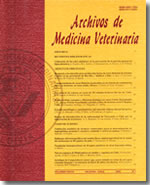Evaluation of the efficacy and persistence of moxidectin (10%) and ivermectin (3.15%) against natural infestation of gastrointestinal nematodes in cattle from the Mexican tropics
Main Article Content
Abstract
The efficacy and persistence of ivermectin-3.15% (IVM-3.15%) and moxidectin-10% (MOX-10%) against natural infections of gastrointestinal nematodes (GIN) in cattle in the Mexican tropics were evaluated. Thirty-three heifers were divided into three groups of 11 animals each, receiving the following treatments: group one treated with IVM-3.15% (0.63 mg/kg bw) subcutaneously, group two was treated with MOX-10% (1.0 mg/kg bw) subcutaneously, and group three was the untreated control group. The egg counts per gram of feces were determined by McMaster test on days 0, 3, 7, 14, 35, 56, 63, 70, 77, 84, 91 and 98 post-treatment (PT). Also, larval cultures were performed to identifying L3 nematodes from the strongylida order by the Corticelli-Lai technique. IVM-3.15% and MOX-10% had similar efficacy (P < 0.001) from day 3 to 70 PT (100-75.7% and 100-93.1% respectively). MOX-10% showed greater persistence than IVM-3.15% at day 77 PT. The identified genera of nematodes from the strongylida order were Cooperia, Oesophagostomun, Ostertagia, Haemonchus and Trichostrongylus, the latter two being the most frequent. We conclude that IVM-3.15% and MOX-10% have good efficacy for controlling natural infections of GIN up to day 70 PT, and MOX-10% have greater persistence compared to IVM-3.15%, although its effectiveness was low at day 77 PT (40.8%). It is concluded that IVM-3.15% and MOX-10% subcutaneously have a good efficacy for controlling natural infections of GIN of the strongylida order. It was observed that MOX-10% have greater persistence than IVM-3.15% (93.1% and 75.7% of efficacy at 70 days PT, respectively), probably associated with the higher dose of MOX applied (1.6 times).

